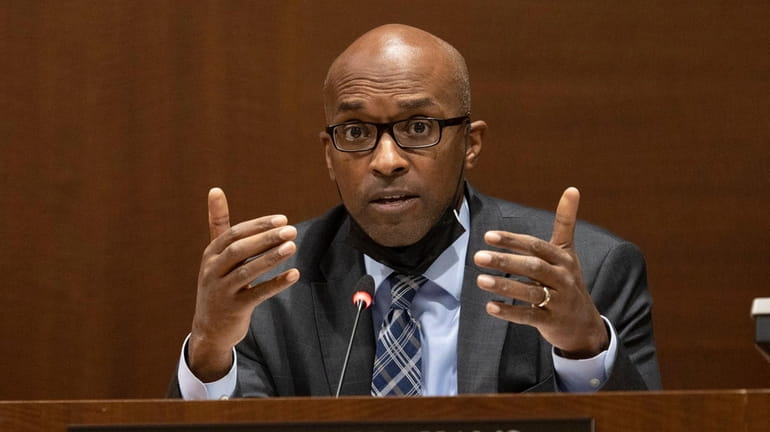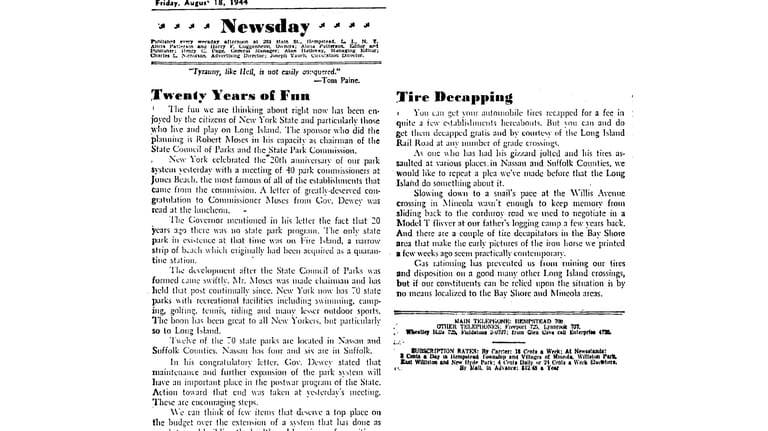Nassau Dems' turn to seek fairness on redistricting

The Nassau Legislature's Minority Leader Kevan Abrahams (D-Freeport). Credit: /Howard Schnapp
Daily Point
Nassau Dems blast ‘conflict’ in election schedule
The New York State Legislature’s proposed new district maps for Congress and for both houses in Albany were voided in court based on a failure to follow a prescribed procedure in state law. That way, Republicans in the minority got the courts to rewrite the lines more favorably for their own electoral chances.
Now, amid all the attention on redistricting, other “out” parties in local and town legislatures are pressing majority powers-that-be on Long Island to get themselves heard on how and when new maps should be shaped for the 2023 election to avoid gerrymandering by the dominant majority.
In Nassau County, Democrats are trying to prod the GOP majority in the 19-member legislature to act. Attorney David Mejias, the lead Democrat on the bipartisan Temporary Redistricting Advisory Commission, has pushed for that panel to start meeting immediately and planning hearings, before it gets too late in the season.
And now, Minority Leader Kevan Abrahams (D-Freeport) and his caucus have proposed legislation that would advance the deadline for adopting district maps to Jan. 9 from the current March 7 — and to advance by two months, to Nov. 7 of this year, the deadline for the commission to submit its plan.
“Currently, there is a direct conflict between New York State election law and the Nassau County Charter that — if left unresolved — would force candidates to gather petition signatures to qualify for the ballot before final district lines are adopted by the Legislature,” Abrahams said in a statement.
That conflict means, the caucus said, that while the period for circulating designating petitions for the county’s 19 legislative seats is set to start next Feb. 28, the deadline for lawmakers to adopt the lines under which those petitions must be filed doesn’t come until a week later.
Republicans haven’t commented either way on the measure so far — with a spokesman telling The Point only that the current statute will “in no way prohibit the redistricting commission and legislature from performing their tasks within the right time line.”
It’s a good bet that before clarity is achieved on this issue, there will be contention and confusion. After all, it’s redistricting.
— Dan Janison @Danjanison
Talking Point
No senioritis
The trope that older voters can be counted on to cast their ballots proved exceptionally true on Long Island this June.
In Suffolk County, voters 50 and older represented almost 90% of the turnout for the June 28 primary. In Nassau, that voting bloc accounted for almost 80% of the total, according to an analysis of county voting records commissioned by AARP New York.
The figures are particularly significant because 50-plus voters make up just over 50% and just under 60% of registered voters in Suffolk and Nassau, respectively.
This pattern holds true even beyond strange contests like the one in June, when the big ticket was a pair of gubernatorial primaries featuring solid front-runners, plus candidates for Congress and State Senate weren’t even on the ballot. Long Islanders in this age bracket have displayed similar overperformance in turnout in general elections in 2021, 2020, and 2019, according to AARP, the well-known organization for the aging.
The findings show the real challenges that political leaders could face in trying to excite young voters in upcoming elections.
The voting data contains a few other noteworthy nuggets: Long Island’s 50-plus crowd represented a bigger percentage of the June 28 turnout than that of seniors in New York City, the only other jurisdiction included in this NY analysis for AARP. On the individual borough level, only seniors in the Bronx and Staten Island came close to matching the Nassau turnout figure — both counties saw 78% of their turnout from those 50 and older.
Then there is the party breakdown. For Suffolk, the 50-plus voters who cast ballots for the June primaries were much more likely to be Republicans than Democrats: 27,299 were Republicans and 18,544 were Democrats. This is particularly significant given that there are more registered Democrats than Republicans in the county. In general, older voters skew Republican in the county.
The AARP didn’t get as good numbers for Nassau, but did find a more even split in party voting among seniors in June: 42,665 of the 50-plus voters were Democrats and 40,931 were Republicans.
— Mark Chiusano @mjchiusano
Pencil Point
A little break

Credit: The San Diego Union-Tribune/Steve Breen
For more cartoons, visit www.newsday.com/nationalcartoons
Reference Point
The yin and yang of LI

The Newsday editorials from Aug. 18, 1944.
Living on Long Island has always been an exercise in dealing with both yin and yang. The traffic jam to get to the beach. The potholed roads navigated on the way to the bucolic East End. The devastating nor’easter that fosters deep bonds among neighbors who work together to recover.
Newsday’s editorial board tapped into such dichotomies way back in 1944 when it wrote about the region’s burgeoning state park system in an Aug. 18 piece called “Twenty Years of Fun” — then followed that with a screed about the damage done to motorists’ tires by Long Island Rail Road grade crossings titled “Tire Decapping.”
The occasion for the first editorial was the 20th anniversary of the state park system and a celebration at Jones Beach that also honored the system’s commissioner, Robert Moses — another yin-yang exemplar for the praise and enmity he inspired over the years.
The editorial board noted that when the state park system was created in 1924 there was only one such facility on Long Island, Fire Island State Park, “a narrow strip of beach which originally had been acquired as a quarantine station.” That was a reference to the old Surf Hotel, which the state acquired in 1892 amid fears that cholera might spread from passengers on New York-bound ships. That, in turn, sparked an early NIMBY uprising in which angry locals sought an injunction and occupied the site. Nowadays, we know the area as Robert Moses State Park.
Back to 1944. By then, the state had 70 state parks including 12 on Long Island, the board wrote, leading to its observation that “the boon has been great to all New Yorkers, but particularly so to Long Island.”
The festivities included a letter from then-Gov. Thomas Dewey who presciently warned, as the board noted, that “maintenance and further expansion of the park system will have an important place in the postwar program of the State. Action toward that end was taken at yesterday’s meeting. These are encouraging steps.”
As Long Islanders know, however, funds for maintenance and expansion did not always flow appropriately in the decades that followed, another manifestation of yin and yang.
But the celebratory air of that editorial was followed by outrage.
“You can get your automobile tires recapped for a fee in quite a few establishments hereabouts,” the board wrote. “But you can and do get them decapped gratis and by courtesy of the Long Island Rail Road at any number of grade crossings. As one who has had his gizzard jolted and his tires assaulted at various places in Nassau and Suffolk Counties, we would like to repeat a plea we’ve made before that the Long Island do something about it.”
The board compared the Willis Avenue crossing in Mineola to a “corduroy road we used to negotiate in a Model T flivver at our father’s logging camp” and colorfully criticized “a couple of tire decapitators in the Bay Shore area that make the early pictures of the iron horse we printed a few weeks ago seem practically contemporary,” before asserting that “if our constituents can be relied upon the situation is by no means localized to the Bay Shore and Mineola areas.”
Of course, the Willis Avenue grade crossing was eliminated recently as part of the Third Track project and countless other crossings are generally gentler these days if not as smooth as silk. So something was indeed done about it, as the board pleaded.
Which is not to say that rim-rattling roads are extinct in the region. It wouldn’t be Long Island, after all, if we didn’t have to endure some pain on the way from our home refuges to our park escapes.
— Michael Dobie @mwdobie and Amanda Fiscina @adfiscina
